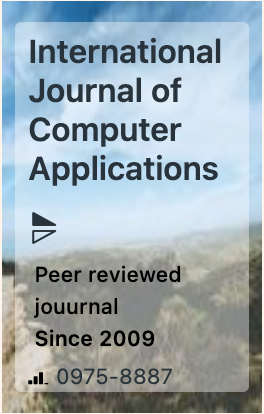The week's pick
Random Articles
Reseach Article
Designing Multi-Tenant E-Learning Systems in the Cloud: A Process-Oriented Approach for Higher Education
| International Journal of Computer Applications |
| Foundation of Computer Science (FCS), NY, USA |
| Volume 187 - Number 10 |
| Year of Publication: 2025 |
| Authors: Sameh Azouzi, Sonia Ayachi Ghannouchi |
 10.5120/ijca2025924998
10.5120/ijca2025924998
|
Sameh Azouzi, Sonia Ayachi Ghannouchi . Designing Multi-Tenant E-Learning Systems in the Cloud: A Process-Oriented Approach for Higher Education. International Journal of Computer Applications. 187, 10 ( Jun 2025), 16-24. DOI=10.5120/ijca2025924998
Abstract
This study examines the shortcomings of conventional Learning Management Systems (LMSs) and introduces a cloud-based solution tailored to the varied requirements of higher education institutions. It proposes a configurable and reusable multi-tenant e-learning process, modeled using the Business Process Feature Model (BPFM). This model integrates principles from Software Product Line (SPL) engineering and Business Process Management (BPM), enabling dynamic scalability, flexible deployment, and efficient resource sharing. The approach is validated through a real-world case study, which highlights its practical benefits and its capacity to improve flexibility, collaboration, and cost-efficiency in modern e-learning environments.
References
- Attaran, M., Attaran, S., & Celik, B. G. (2017). Promises and challenges of cloud computing in higher education: a practical guide for implementation. Journal of Higher Education Theory and Practice, 17(6), 20-38.
- Al Tayeb, Abdulelah, et al. "The impact of cloud computing technologies in e-learning." In-ternational Journal of Emerging Technologies in Learning (iJET) 8.2013 (2013): 37-43.
- N. Sultan: “Cloud Computing for Education: A New Dawn,International Journal of Infor-mation Management, n.30, pp. 109–116.,2010http://dx.doi.org/10.1016/j.ijinfomgt.2009.09.004.
- Azouzi, S., Ghannouchi, S. A., & Brahmi, Z. (2017, September). Software Product Line to Express Variability in E-Learning Process. In European, Mediterranean, and Middle Eastern Conference on Information Systems (pp. 173-185). Springer, Cham.
- Ankit Bhilwar, Sandesh Jain, others: “multi-tenant enabled e-Learning platform: Blended with workflow technologies”, e-Learning, e-Management and e-Services (IC3e), 2014 IEEE Conference on, pp. 88—92, 2014.
- MilindaPathirage, Srinath Perera, IndikaKumara, SanjivaWeerawarana: “A multi-tenant architecture for business process executions”, Web services (icws), 2011 ieee international conference on, pp. 121—128, 2011.
- Khadija Aouzal, Hatim Hafiddi, Mohamed Dahchour: “An overview of variability management in cloud services”, Cloud Technologies and Applications (CloudTech), 2015 International Conference on, pp. 1— 5, 2015.
- M. Abu-Matar, et al., “Towards Software Product Lines Based Cloud Architectures”, Proceedings of the IEEE Conference on Cloud Engineering, 2014.
- AssylbekJumagaliyev, Jonathan Nicholas David Whittle, Yehia Said Shahat Ahmed Elkhatib: “Evolving multi-tenant SaaS cloud applications using model-driven engineering”, 2016.
- R. Mietzner, et al., “Variability modeling to support customization and deployment of multi-tenant-aware Software as a Service applications", Proceedings of the 2009 ICSE Workshop on Principles of Engineering Service Oriented Systems, pp. 18-25, 2009.
- Liu, F.; Tong, L.; Mao, J.; Bohn, R.; Messina, J.; Badger, L.; Leaf, D.: NIST Cloud Computing Reference Architecture. NIST Special Publication 500-292, 2011.
- Stifani, R.; Pappe, S.; Breiter, G.; Behrendt, M.: IBM Cloud Computing Reference Architecture. IBM Academy of Technology Volume 3, Number 1, 2012.
- Thomas Barton, Christian Seel: “Business process as a service-status and architecture.”, EMISA, pp. 145—158, 2014.
- V. Mark, “Modeling Business Process Variability”, University of Twente, 2007.
- R. Cognini, Corradini, F.A, Polini, B. Re, Business process feature model: an approach to deal with variability of business processes, Domain-Specific Conceptual Modeling,2016.
- K. Lee, et al., “Concepts and guidelines of feature modeling for product line software engineering”, Proceedings of the 7th Conference on Software Reuse: Methods, Techniques, and Tools, pp. 62–77, 2002.
- H. Gomaa, “Designing Software Product Lines with UML: From Use Cases to Pattern-Based Software Architectures”, Addison-Wesley Professional, 2004.
- M. Lebrun, “La formation des enseignants aux TIC : allierpédagogie et innovation,” Centre NTE, vol. 1, pp. 11-21, 2004.
- P. H. C. Gérald, H. Sergio, J. François, M. Jacques, “Treize scénariosd’activités de cours avec Moodle’’, p. 294, 2013.
- N. Kratzke, “Virtual Labs in Higher Education of Computer Science Why they are Valuable? How to Realize? How much will It Cost?”, Education, vol. 2, no. 7, pp. 239–246, 2012.
- P. Pocatilu, F. Alecu, and M. Vetrici, “Measuring the efficiency of cloud computing for E-learning systems”, Wseas Transaction on Computer, vol. 9, no. 1, pp. 42–51, 2010.
- A. Kilanko, F. Adesola, and I. Odun-Ayo, “E-learning on the Cloud – An Analysis”, International Multi Conference of Engineers and Computer Scientists, 2019.
- P. Hendradi, M. Khanapi, and S. N. Mahfuzah, “Cloud computing-based e-learning system architecture in education 4.0”, Journal of Physics, vol. 1196, no. 1, pp. 012-038, 2019.
- V. S. Kushwah and A. Bajpai, “Cloud Computing: A Future e-Learning Environment Cloud Computing: A Future e-Learning Environment”, International Journal Research in Electronics and Computer Engineer., vol. 5, no. 4, pp. 63–67, 2017.
- T. Al-Rousan, B. Al-Shargabi, and F. Alzyoud, “An Overview of Adopting Cloud Computing in ELearning Systems”, International Conference on Information, Communication and Computing Technology, pp. 98–102, 2020.
- W. Qassim Qwaider, “A Cloud Computing Based Learning Management Systems (LMSs) Architecture”, International Jouranl of Computer Network and Technology, vol. 5, no. 2, pp. 51–58, 2017.
- P. Naik, S. Madolli, L. Melagiri, P. Davanageri, and S. Hiremath, “E-Learning Based on Cloud Computing”,Internaitional Journal of Engineering Science, vol. 11756, 2017.
- A. Kilanko, F. Adesola, and I. Odun-Ayo, “E-learning on the Cloud – An Analysis”, International Multi Conference of Engineers and Computer Scientists, 2019.
- P. Hendradi, M. Khanapi, and S. N. Mahfuzah, “Cloud computing-based e-learning system architecture in education 4.0”, Journal of Physics, vol. 1196, no. 1, pp. 012-038, 2019.
- I. Arpaci, “Antecedents and consequences of cloud computing adoption in education to achieve knowledge management”, Computur in Human Behavior, vol. 70, pp. 382-390, 2017.
- M. Bitar, “An analysis of cloud based e-learning providers’ versioning strategy”, Lekinge Institute of Technology, Karlskrona, Sweden, 2017.
- Babu, S. R., Kulkarni, K. G., & Sekaran, K. C. (2014). A generic agent based cloud computing architecture for e-learning. In ICT and Critical Infrastructure: Proceedings of the 48th Annual Convention of Computer Society of India-Vol I (pp. 523-533). Springer, Cham.
- E. Aljenaa, F. S. Al-Anzi, and M. Alshayeji, “Towards an efficient e-learning system based on cloud computing”, Kuwait Conference on e-Services and e-Systems, pp. 1-7, 2011.
- OUF, Shimaa, NASR, Mona, et HELMY, Yehia. An enhanced e-learning ecosystembased on an integration between cloud computing and Web2. 0. In : The 10th IEEE International Symposium on Signal Processing and Information Technology. IEEE, 2010. p. 48-55.
- S. Al Noor, G. Mustafa, S. A. Chowdhury, Z. Hossain, and F. T. Jaigirdar, “A Proposed Architecture of
- Cloud Computing for Education System in Bangladesh and the Impact on Current Education System”, International Journal of Computer Science and Network Security, vol. 10, no. 10, pp. 7-13, 2010.
- Zhang, Y., & Li, J. (2023). Cloud-Native Learning Systems: Trends, Technologies and Future Directions. Journal of Cloud Education Research, 12(1), 33–50.
- Al-Rousan, T., Al-Shargabi, B., &Alzyoud, F. (2023). An Overview of Adopting Cloud Computing in E-Learning Systems. International Conference on Information, Communication and ComputingTechnology.
- Chen, M., & Patel, S. (2024). AI-Driven Personalization in Multi-Tenant E-Learning Environments. International Journal of Cloud Applications in Education, 9(2), 41–59.
- Bitar, M. (2023). An Analysis of Cloud-Based E-Learning Providers’ Versioning Strategy. Blekinge Institute of Technology, Sweden.
- Kilanko, A., Adesola, F., & Odun-Ayo, I. (2023). E-Learning on the Cloud – An Analysis. International Multi Conference of Engineers and Computer Scientists.
Index Terms
Keywords

